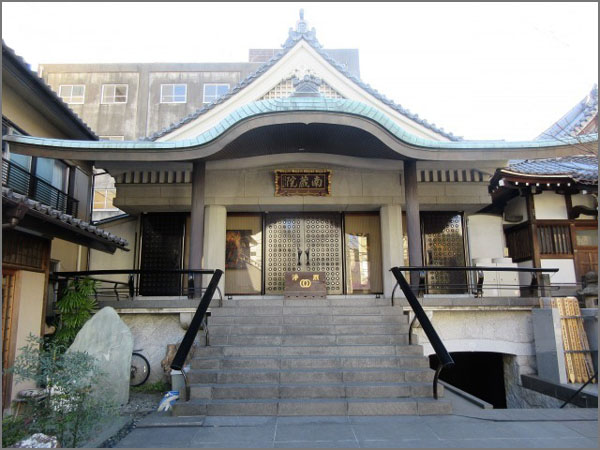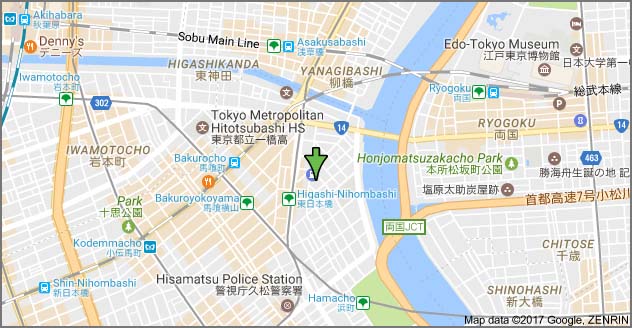[ . BACK to DARUMA MUSEUM TOP . ]
. Gofunai 御府内八十八ヶ所霊場 88 Henro Temples in Edo .
::::::::::::::::::::::::::::::
Nr. 26 - Raifukuji 来福寺 Raifuku-Ji
- 宝林山 Horinzan 地蔵院 Jizo-In 来福寺 Raifuku-Ji
品川区東大井3-13-1 / 3 Chome-13-1 Higashiōi, Shinagawa ward
Shingon Sect : 智山派

来福寺大師堂 Daishi Do Hall
This temple was founded in 990 by priest 智弁阿闍梨 (智瓣) Chiben Ajari.
The main statue is 延命地蔵 Enmei Jizo (経読地蔵 Kyoyomi Jizo), carved by Kobo Daishi.
Related to the shrine 梶原稲荷神社 Kajiwara Inari Jinja .
This Jizo statue had been venerated by 鎌倉権五郎景政 Kamakura Gongoro Kagemasa.
In 1501, a statue of Kyoyomi Jizo, "Jizo reading Sutras", was brought here from the 納経塚 Nokyozuka Mound.
Related to
梶原景季 Kajiwara Kagesue: 梶原塚 Kajiwara-zuka mound, 梶原の松 Kajiwara pine in the compound.
And life-extension cherry tree 延命櫻 in the compound.
The main hall has been reconstructed in 1952.
- quote -
Raifukuji
Hidden in the middle of a quiet residential area just off the Daiichi-Keihin highway in Oimachi, this temple belongs to the Shingon sect of Buddhism and is an eerily quiet oasis found at the end of a beautiful stone path.

The temple's origins
reach back into the 10th century, but the current, rather modern buildings are all built in the postwar era. In addition to the small but lush garden inside the gates, the highlight here is the monument to the indigo dealers of Awa Province (today's Tokushima Prefecture), who plied their trade in Edo from the early 17th century to the Meiji Restoration, keeping the capital's inhabitants stocked up on this blue dye that's still one of Tokushima's most famous exports.
- source : timeout.com/tokyo/museums/
Graves of the Indigo dealers 阿波藍商人墓標群

..............................

Edo Meisho Zue
玉川八十八ヶ所霊場 Nr. 74 of the Tamagawa Henro Pilgrimage
東海三十三観音霊場 Nr. 2 of the Tokai Pilgrimage to 33 Kannon Temples
..............................
- ご詠歌 - chant of the temple 金剛頂寺 Kongocho-Ji in Shikoku :
往生に望みをかくる極楽は 月のかたむく西寺の空
Ōjō ni nozomi o kakuru gokuraku wa tsuki no katamuku Nishidera no sora
..............................
- 朱印 - stamp of the temple :

- Homepage of the temple
- source : tesshow.jp/shinagawa
. Introduction of 延命地蔵 "Jizo for a long life" .
..............................

..............................
- - - - - #edohistory - - - - -
. Kamakura Gongorō Kagemasa 鎌倉権五郎景政 .
(1069 - ?)
..............................
- quote -
Kajiwara Kagesue 梶原景季 / 梶原景時 Kagetoki
(1162 - February 6, 1200),
was a samurai in service to the Minamoto clan during the Genpei War of Japan's late Heian period.
The Heike monogatari records an anecdote about a friendly competition with Sasaki Takatsuna prior to the second battle of Uji. Mounted on Yoritomo's black horse, Surusumi, he races Takatsuna across the River Uji.

Kajiwara Kagesue, Sasaki Takatsuna, and Hatakeyama Shigetada racing to cross the Uji River before the second battle of Uji,
by Utagawa Kuniyoshi.
Kagesue met death in Suruga at the hands of men loyal to Minamoto no Yoriie.
- - - More in the WIKIPEDIA !
梶原稲荷神社 Kajiwara Inari Shrine
relocated here in 1320.

- source and more photos : gogohiderin.blog.fc2.com -
A legend from Nagano 草津町, Kusatsu village
where Kagesue wrote a 狂歌 Kyoka poem about 源頼朝 Minamoto no Yoritomo at Mount Asama, who got stuck there in strong rain:
「昨日こそ浅間はふらめ今日は又みはらし玉へ白雨の神」
After that, it soon stopped raining.
Kajiwara Kagetoki 梶原景時 (?1140 ( ?1162) - 1200)
In the village of 八王子村 Hachioji there is a pine named Kajiwara sugi 梶原杉 Kajiwara Pine.
It grew from a walking staff of Kagetoki, who had cut it out at Shrine 鎌倉八幡 Kamakura Hachimangu and planted it in the compound of this village.
The remains are venerated to our day:

- quote -
Kajiwara Kagetoki (梶原 景時, c.1162 – February 6, 1200)
was a spy for Minamoto no Yoritomo in the Genpei War, and a warrior against the Taira. He came to be known for his greed and treachery.
"A prominent eastern warrior", he supplied Yoshitsune with a number of ships after the Battle of Yashima.
Originally from Suruga province,
Kajiwara entered the Genpei War fighting under Oba Kagechika, against the Minamoto.

After the Taira victory at Ishibashiyama in 1181, he was sent to pursue the fleeing Minamoto no Yoritomo. Having discovered him, Kajiwara switched sides, leading his forces in another direction, and turning to Yoritomo's cause.
Three years later,
Kajiwara would lead the forces of Minamoto no Yoshitsune and Yoritomo into battle against their cousin Yoshinaka, and against the Taira.
Attached to Yoshitsune's force,
Kajiwara reported back to Yoritomo on Yoshitsune's actions, in order to satisfy Yoritomo's suspicion and distrust of his brother. In one particular episode related in The Tale of the Heike, Kajiwara suggests, during the Battle of Yashima, that Yoshitsune equip the Minamoto ships with "reverse oars" should they need to retreat quickly. Yoshitsune responds with distaste to Kajiwara's advice, humiliating him by saying such an act would be cowardice. From that point until Yoritomo's death, the resentful Kajiwara did as much as he could to raise tensions between the brothers. His slander led Yoritomo, already suspicious of his younger brother, to eventually accuse Yoshitsune of plotting against the bakufu, which then led to his exile and eventual death.
Even after this,
when the shogunate was successfully and firmly established, Kajiwara still caused tensions at court. He accused Yuki Tomomitsu of plotting against the Shogun Minamoto no Yoriie; a number of members of the court tried to get rid of him, who eventually left for Suruga. The following year (1200), he was defeated and killed in battle along with his son Kagesue.
Kajiwara Heima, a senior retainer of the Aizu domain in the 19th century, claimed descent from Kagetoki. His formal name, Kagetake (景武) shares a character with Kagetoki's name.
- - - More in the WIKIPEDIA !
..............................
kyooyomi Jizoo 経読地蔵 Kyoyomi Jizo Bosatsu reciting Sutras
There are some legends in various temples.
Kamakura 宝戒寺 Hokai-Ji

子育経読地蔵
Made in 1366 by 三条法印憲円 Sanjo Hoin Kenen. 90 cm high.
Once a woman broke down crying in front of Temple Hokai-Ji, ready to give birth.
A friendly priest came out and helped her. This must have been Jizo Bosatsu himself, people who heared her tell the story thought.
From that time on, many people at night heared a voice coming from the Jizo Statue, reading the sutras.
- reference source : www8.plala.or.jp/bosatsu -
..............................
Suruga 国分寺 Kokubun-Ji

Near a water basin where Tokugawa Ieyasu used to wash his hands, there was a voide every night reciting the sutras.
That was very strange so one night, so when he peeked out, he saw a statue of Jizo by the basin, reciting the sutras.
He then had a hall build at 浅間神社 Asama Sengen Jinja to place the statue properly.
In the Meiji period it was replaced to its present location. Even then some people claim to have heared it recite the sutras.
- reference source : blog.goo.ne.jp/syuji -
..............................
- reference : 経読地蔵 -
..............................
shio Jizoo 鹽地蔵 "Salt Jizo" (see Nr. 27 below)
Kyoozenji 教善寺 Kyozen-Ji
港区六本木5-1-9 / 5 Chome-1-9 Roppongi, Minato ward
People come here and offer some 塩 salt with the wish to have their eye disease healed.
Genkakuji 源覚寺 Genkaku-Ji
文京区小石川2-23-14 / 2 Chome-23-14 Koishikawa, Bunkyō ward
..............................
shio Jizoo 塩地蔵 "Salt Jizo"
東京とその近郊の塩地蔵図鑑
- reference source : 石仏散歩 -
..............................
. Shioname Jizo 塩嘗地蔵 Salt-tasting Jizo in Kamakura .
. Jizō - Jizo Bosatsu 地蔵菩薩 - ABC List .
::::::::::::::::::::::::::::::
Nr. 27 - Shookooin 正光院 Shoko-In
- 瑠璃山 Rurizan 正光院 Shoko-In
港区元麻布3-2-20 / 3 Chome-2-20 Motoazabu, Minato ward
Shingon Sect : 真言宗

This temple was founded in 1630 by High Priest 法印宥専大和尚,
on behalf of 筑前福岡2代藩主 黒田忠之 Kuroda Tadayuki, second Daimyo of the Chikuzen Fukuoka Domain.
Tadayuki had called priest 宥専 from Mount Koyasan, where he had venerated the statue of Yakushi Nyorai, also named 里俗子安薬師 Rizoku Koyasu Yakushi.
The temple became the clan temple for the Kuroda family.
The main statue is 薬師如来 Yakushi Nyorai / 子安薬師 Koyasu Yakushi to protect children .
The statue was made by 恵心僧都 源信 Eshin Sozu Genshin in the middle Heian period, carved at the birth of 一条天皇 Ichijo Tenno (980 - 986) with the prayers for the baby to grow up healthy. This wooden statue was lost in WWII, the present statue is a gift from Mount Koyasan.
In the compound are also halls for 不動堂 Fudo Myo-O and 地蔵堂 Jizo Bosatsu.
The Fudo Hall is also known as 麻布大山不動.
The Jizo hall is also known as 子育鹽地蔵. (Salt Jizo)
The Jizo is a stone statue, originally placed at the shrine 霞山櫻田神社 Kazan Sakurada Jinja , which was in the compound of the temple.
. Azabu Fudozaka no Ichigan Fudo .
. Ichijō-tennō, Ichijoo Tennoo 一条天皇 Emperor Ichijo / Ichijyo .
(980 – 1011) - the 66th Emperor
..............................
- ご詠歌 - chant of the temple 神峯寺 Konomine-Ji in Shikoku :
みほとけのめぐみの心神峯山も誓いも高き水音
Mihotoke no megumi no kokoro koonomine yama mo chikai mo takaki mizuoto
. 27 - 竹林山 Chikurinzan 地蔵院 Jizo-In 神峯寺 Konomine-Ji / Shikoku .
..............................
- 朱印 - stamp of the temple :

- Homepage of the temple
- source : tesshow.jp/minato
. Introduction of Yakushi Nyorai .
..............................

..............................
- - - - - #edohistory - - - - -
. The Kuroda clan of Fukuoka .
Kuroda Kanbei Yoshitaka 黒田官兵衛 孝高 - (1546 - 1604)
His son, Kuroda Nagamasa 黒田長政 - (1586 - 1623)
..............................
Sakuradajinja 櫻田神社 Shrine Sakurada Jinja
- quote -
One of the most interesting shrines found in Roppongi is the Sakurada Shrine. The shrine sits right within a standard busy street and can only be recognized by the large torii gate out front. Once you pass through the torii gate, it feels as though you have been transported out of the big city of Roppongi and deep into nature. The shrine is surrounded in luscious trees and greenery and is absolutely stunning.
The prize possession of the Sakurada Shrine
is their extremely large Ten-sui-oke 天水桶, a kind of basin for saving water from rain.

The Ten-sui-oke
at this shrine has existed for over 200 years. In Japanese, "ten" means the sky or heaven, "sui" means water, and "oke" means pail or box. When we visited the Sakurada Shrine, we were taught by one of the priests that rain is a present from the kami (Shinto deities) of the sky. This is believed because the houses from this time period were only made out of wood, and therefore house fires were very common. The Japanese believed that the rain was given to them by the kami so that they had a force to fight back against fires. The Japanese believed that the only way to put out their fires is with rain that had been presented by the kami. This is why "rain" at the time was referred to as "tensui" or "heaven water." This story truly shows the spirit and culture behind Japanese religion and faith.
- source : sanpai-japan.com/2016 -
::::::::::::::::::::::::::::::
- reference : 御府内八十八 来福寺 -
- reference : 御府内八十八 正光院 -
::::::::::::::::::::::::::::::
- Koya San in Wakayama 和歌山 高野山 -
- Kobo Daishi Kukai 弘法大師 空海 (774 - 835) -
. Gyoki Bosatsu 行基菩薩 (668 - 749) Saint Gyōki .
. Shikoku Henro Temple List 四国遍路 .
. Gofunai 御府内八十八ヶ所霊場 Pilgrimage to 88 Henro Temples in Edo .
- Introduction -
::::::::::::::::::::::::::::::

. Join the Updates of Facebook ! .
::::::::::::::::::::::::::::::
. Japan - Shrines and Temples - ABC .
. Welcome to Edo 江戸 ! – The Edopedia .
[ . BACK to DARUMA MUSEUM . TOP . ]
[ . BACK to WORLDKIGO . TOP . ]
- - - - - @edopilgrims #edohenro #raifukuji #shokoin - - - - -
::::::::::::::::::::::::::::::
--
Posted By Gabi Greve to Gokuraku - Jigoku on 1/18/2017 01:36:00 pm











































